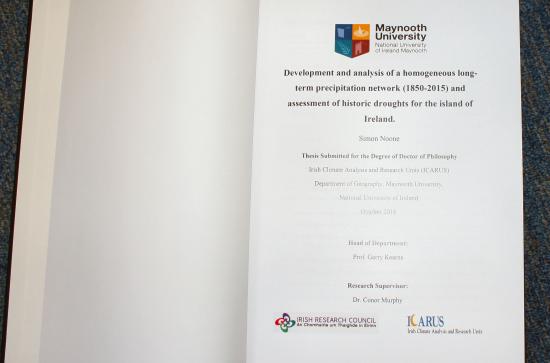
ICARUS student Simon Noone submits PhD. thesis: Development and analysis of a homogeneous long-term precipitation network (1850-2015) and assessment of historic droughts for the island of Ireland.
Abstract
Long-term precipitation series are critical for understanding emerging changes to the hydrological cycle. Given the paucity of long-term quality assured precipitation records in Ireland this thesis expands the existing catalogue of long-term monthly precipitation records for the Island by recovering and digitising archived data. Following bridging and updating, 25 stations are quality assured and homogenised using state-of-the-art methods and scrutiny of station metadata. Assessment of variability and change in the homogenised and extended precipitation records for the period 1850-2010 reveals positive (winter) and negative (summer) trends. Trends in records covering the typical period of digitisation (1941 onwards) are not always representative of longer records. Using this quality assured network of precipitation stations together with proxy rainfall reconstructions a 250 year historic drought catalogue is established using the Standardised Precipitation Index (SPI). Documentary sources, particularly newspaper archives, spanning the last 250 years are used to (i) add confidence to the quantitative detection of drought episodes and (ii) gain insight to the socio-economic impacts of historic droughts. During the years 1850-2015 seven major drought rich periods with an island wide fingerprint are identified in 1854-1860, 1884-1896, 1904-1912, 1921-1924, 1932-1935, 1952-1954 and 1969-1977. These events exhibit substantial diversity in terms of drought development, severity and spatial occurrence. Results show that Ireland is drought prone but recent decades are unrepresentative of the longer-term drought climatology. Finally, long-term homogenous precipitation records are further utilised to reconstruct river flows at twelve study catchments to 1850. Reconstructed flows are analysed to identify periods of hydrological drought and the potential of different SPI accumulations to forecast severe drought are explored. Results demonstrate the importance of catchment characteristics in moderating the effects of meteorological drought and highlight the potential for drought forecasting in groundwater dominated catchments. The body of work presented considerably advances understanding of the long-term hydro-climatology of a sentinel location in Europe and provides datasets and tools for more resilient water management.
